From 0% to 70% of the market: How did Google Chrome absorb the Internet?
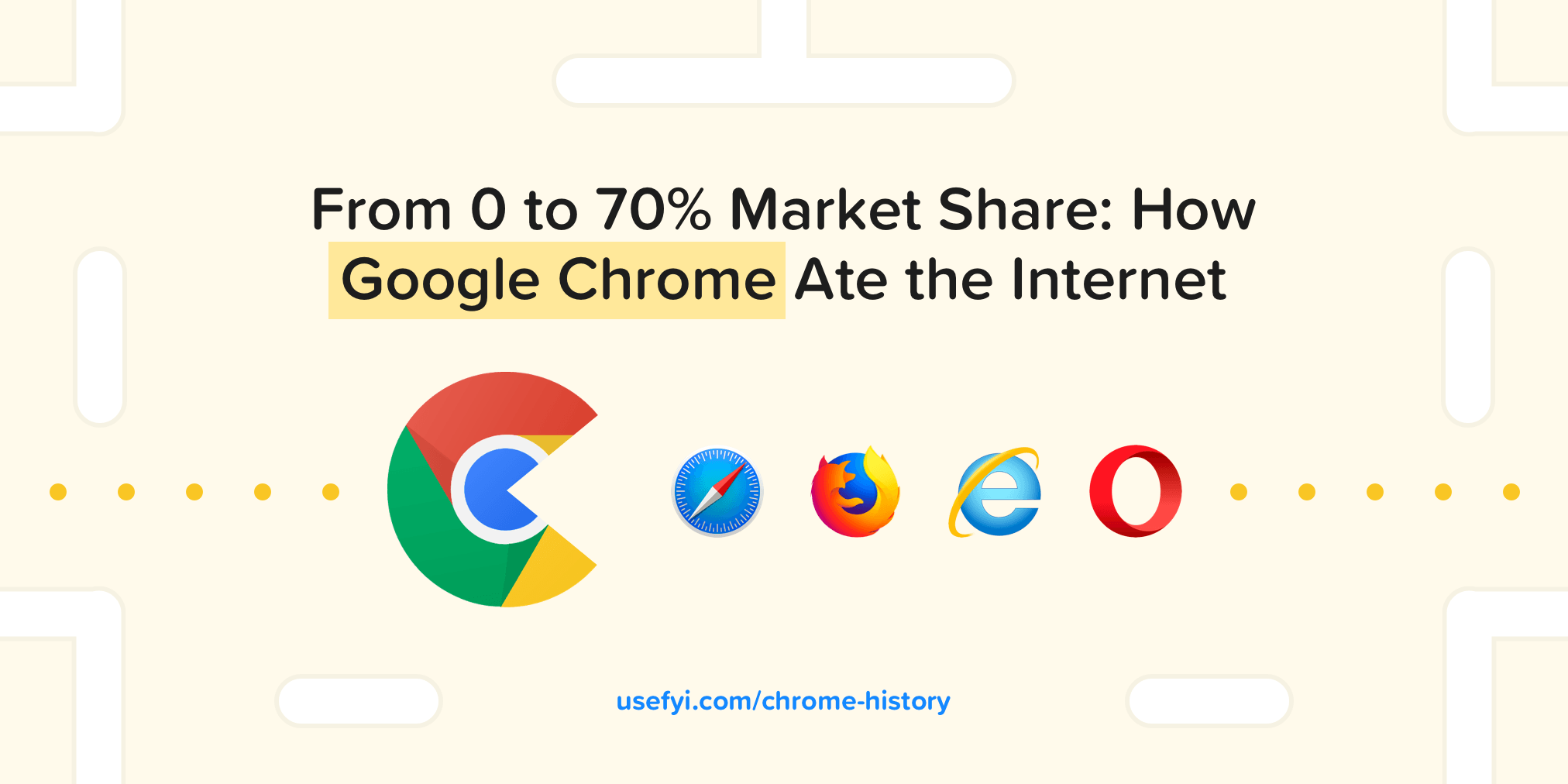
In 2008, Microsoft's Internet Explorer accounted for nearly 60% of the global browser market . Mozilla's Firefox ranks far in second, taking up about a third of the market. Google Chrome debuted in the market on September 2, 2008 and occupied only 0.3% of the market.
A decade later, Chrome actually took over the entire browser space - 70% of the market . How did Google enter and dominate a completely new sector in just ten years?
The invention of a fundamentally new browser.
Google viewed Chrome as a platform from the start. For them, the browser was not just a means of viewing web pages. It was a set of diverse tools and applications that influenced our interaction with the Internet as a whole.
What will be discussed in this article:
- Why were developers, not regular internet users, the primary goal of Google Chrome?
- How has Google been able to significantly increase the Chrome user base in a short period of time in an already captured market?
- How has Chrome allowed Google to influence trends on the web?
Chrome is not just a great browser, it is also a great example of how one product can challenge a common approach and change the way we use tools every day.
The Internet of 2008 was very different from what we see now. The usual ways of interacting with him have just begun to change. Google discovered the possibility of creating a completely new operating system (OS) for the open Web, with the expectation of capitalizing on the self-confidence and limitations of Microsoft and their Internet Explorer. Vulnerabilities that Google were not afraid to take advantage of.
2008-2013: Rethinking the browser

2008 year. Apple's iPhone has been on sale for less than a year. Windows 7 has been available for months, and people are still puzzled by the fate of Windows XP. Yahoo! just rejected a Microsoft offer to acquire the company at $ 31 per share. And Internet Explorer is the most popular web browser in the world.
Then the ecosystem around consumer technology was very different, not only in terms of hardware. The iPhone release was the catalyst that made apps mainstream, but the problem was that they hadn’t gained momentum yet. Of course, they were popular, but not at all ubiquitous, as they are today, and most people remained loyal to online services.
At that time, online banking was not new, but users still had to go to a password-protected web page to access their account information. It was possible to order goods via the Internet, but rather from a desktop computer or laptop than from a mobile device.
The Internet has been changing rapidly, but browsers are not. Microsoft made some improvements to its Internet Explorer, but for the most part that in 1998, that in 2008, Internet navigation using IE remained unchanged.
Google understood that the world needed something new to fulfill its promise of Web 2.0. They also understood that they could defeat Microsoft on their own field if they moved fast enough and could play their cards correctly.
Google Chrome was officially launched in beta on September 2, 2008. To spread the word about this, Google released a small comic strip explaining why they created their own browser.

A team of experienced developers was assembled to create Chrome. Responsible for the Chrome project as a whole, including recruitment was Ben Goodger, who managed to work in Netscape and Firefox, and in 2005 came to Google. Between 2005 and 2006, Google connected several well-known developers from Firefox, including Darin Fisher, Pam Green and Brian Rainer. Their task was to create a completely new type of browser, built on the basis of HTML markup, WebKit, which would support constantly included web applications, such as Google Maps.
Despite the problems associated with creating completely new and unexplored web technologies, the Chrome team had one decisive advantage over competitors - they started from scratch. Google could not worry about any templates, backward compatibility and other legacy code problems, while engineers from IE and Firefox had to refine their browsers without much maneuverability.
At the very early stages, it was decided that Chrome would work with each tab as a separate "sandbox", highlighting it with its own process. This approach solved several problems at once. Firstly, it ruled out the impact of failures in one tab on others, which led to a more stable use of the Internet. Secondly, it increased overall productivity due to parallel processes. Thirdly, this approach corresponded to a new concept - an application, not a page.
"Our browsers should separate tabs into separate processes, make all interactions with the operating system multithreaded, increase the size of the cache and not be afraid to manage high bandwidth when it is available. Internet Explorer 8, Firefox 3.1 and Apple Safari use new approaches, but Google Chrome "there’s an advantage in getting started with some radically new features that are currently not possible in other browser architectures." - Niall Kennedy
Google didn’t mess around and, by its own admission, rethought the whole concept of the browser from scratch. They looked for basic and complex problems with browser technology and sought to solve them more efficiently than anyone else.
Although Google was not shy about announcing their intentions for a future web browser, the way Chrome worked was completely unusual. Google relied on aspects of the Apple WebKit and Firefox Mozilla rendering engine to create Chrome, but they didn’t just want to create a better browser, they wanted to collaborate with the best developer enthusiasts. That is why all the source code of the browser was made publicly available, as part of the Chromium project in September 2008.
This was a good step for two reasons:
- Having an open Chromium project gave Google a great way to consistently improve Chrome as a complete product.
- This is in full compliance with open-web standards, which have become increasingly popular thanks to the support of the open-source community and organizations such as Mozilla.
It also played into the hands of Microsoft taking the completely opposite approach to developing IE, keeping it a secret.
By July 2009, just nine months after its official launch, more than 30 million people were using Chrome. The new browser was fast, very fast, and users noticed it. In July 2009, Google also announced its new Chrome operating system .
“We are developing the operating system in such a way that it is quick and easy, so that in a few seconds it can be launched and connected to the Internet. The user interface should be minimal so as not to interfere with you, and most of the work should take place on the Internet. As with with Google Chrome, we go back to the basics and completely redo the basic OS security architecture so that users don’t have to deal with viruses, malware and security updates. It should just work. "- Google
In December 2009, Google launched its gallery of extensions . The presence of many third-party plug-ins, ready to be installed in Chrome to give it additional functions, showed how versatile the browser can be.

Extensions, plugins, and add-ons are common today, but in 2009 it was a pretty radical concept. You could be wrong, but parallel tabs and extensions are a defining feature of Chrome as a product, and they were wildly popular. By December 2010, just a year after the extension gallery was launched, more than 8,500 extensions and 1,500 browser themes were available. About one third of the 120 million Chrome users had at least one extension installed, and the total number of installations was close to 70 million.
In 2010, the number of Chrome users increased significantly: from 40 million users at the beginning of the year to more than 120 million by the end of 2010. The main factor behind this growth was the speed of Chrome. In addition to its user base, Google has also significantly increased its browser market share. At the end of 2009, Chrome occupied about 5% of the market, and only 15% in a year.
"Chrome is turning a browser into a dream and getting better. Firefox, Safari, Internet Explorer, and Opera should pay attention to this: Chrome is a worthy adversary." - Farhad Manju , Salon
People wanted a faster and lighter browser and got Chrome. Internet Explorer may still have been the dominant browser by the end of 2010, but Google was already approaching. Ironically, Google defeated Microsoft in their own game. Being weary of the struggle with the federal government for the anti-competitive practice of combining IE with Windows to effectively dominate the market, Microsoft soon found themselves on the verge of losing in the same strategy. By making a faster and easier alternative to IE, Google has gained an invaluable advantage over Microsoft, giving users the ability to set Chrome as their default browser. Just a couple of steps and Google becomes the default search engine for Chrome users.
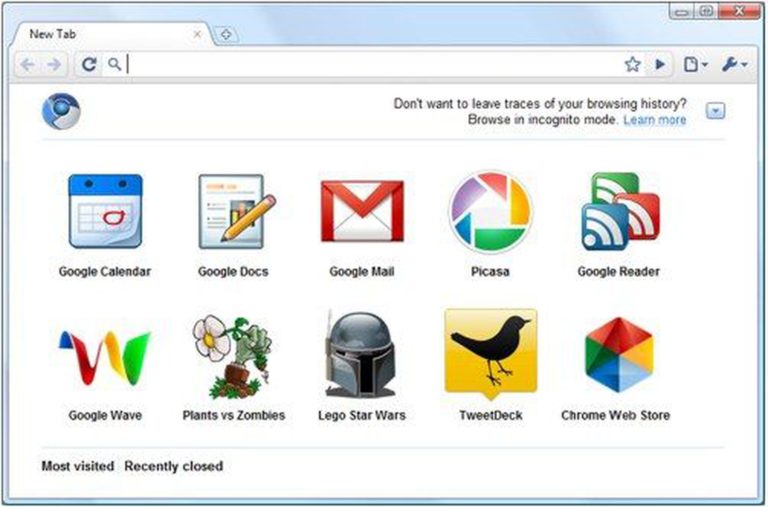
Google ended 2010 with the launch of the Chrome Web Store. Initially, the Chrome Web Store, available only in the United States, was a larger and better embodiment of the Google extension gallery. Through the Chrome Web Store, users can view and install extensions, plugins, and themes from thousands of independent developers. Extensions and plugins available through the Chrome Web Store have made the browser significantly more versatile. It has also made extensions an important part of the wider Chrome ecosystem, a smart long-term game based on Chrome’s flexibility and focused on the needs and expectations of the user.
Like Firefox plugins, Chrome extensions were not just popular little tools to help users work more with their browsers. They were the vanguard of a new wave of software products that would ultimately change entire industries, putting the user first. Take, for example, Adblock Plus.
Adblock Plus is one of the oldest browser extensions since 2007. It has been downloaded and installed millions of times and is one of the easiest and most effective extensions available for Chrome and Firefox. Adblock Plus has almost single-handedly changed people's attitudes towards traditional online publications and the viability of certain online advertising business models. It can be argued that Adblock Plus, the only extension developed by one publisher, helped create the subscription model that we see today everywhere, from streaming entertainment services to SaaS. It is so popular that it literally changed the web and this is what makes extensions so powerful.
The beginning of 2011 was mostly quiet for Google. That all changed in March 2011, when Chrome got its first major design. The original Chrome logo has been redesigned to a three-dimensional metallic style to refer to the product name. However, by 2011, the Chrome 3D logo was already pretty outdated. In combination with Apple's trend toward “flat design,” it became clear that an update was inevitable. The new, simpler and more understandable Chrome logo reflects the usability of the product without unnecessary interference. The bluish logo for the open source Chromium project has also changed.

Soon after the Chrome logo was redesigned, Google announced its Chromebook netbook line. Google presented the Chromebook as the future of lightweight laptops. These machines did not have a traditional hard drive, and software cannot be installed on them. Instead, they will launch Chrome OS and rely on Chrome itself as the primary means of users accessing the Internet.
In October 2011, Chrome was quietly updated, with the addition of a new feature that other browsers will soon imitate - the new tab page . The tabs had to be flexible in order to meet the needs of many users and give them the power of true online multitasking. Before the tabs appeared, most people probably would not have opened a new browser window for every task they wanted to work on. Tabs not only made this kind of online process possible, but even preferable. However, until now, the opening of a new tab has remained underestimated. In addition to the user's predefined homepage, the new tab was an empty page. Now, the new Chrome tab has made Chrome even more like an application, giving users quick access to the extensions, pages, and sites they used the most.
The next step was to go beyond Windows. In February 2012, Google released Chrome for Android. Supporters of Google have been patiently waiting for the Android browser version for years. The only real surprise at launching Chrome for Android is how long it took Google to release it.
Three months after the release of Chrome for Android, Google introduced their latest physical product - Chromebox , a compact device designed as a desktop computer with the Chrome operating system. However, like the Chromebook, the Chromebox did not impress a wide audience.
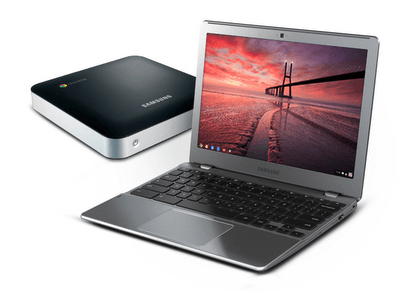
The biggest problem with Chromebox was not even the product itself, although many analysts and journalists noted the high price and low specifications of Chromebox . The problem was the banal lack of demand for it.
When Google first came up with the idea of a lightweight laptop designed and optimized for cloud computing, this concept had promising prospects. April 3, 2010 the situation changed almost overnight. It was then that Apple introduced the first iPad, and suddenly the idea of paying a high price for a cut-down laptop without a hard drive and with very limited offline functions became not as attractive as it was before. Apple alone has changed the horizons of the consumer electronics market.
“Let’s speculate. Samsung’s new Chromebook and Chromebox are too expensive for what you get. A Chromebox costs $ 329 — a huge amount for a Celeron desktop computer. Faced with the choice of equipping the office with a set of Retina displays for the iPad — that can access 700,000 iOS apps and remain extremely portable - compared to laptops that can't even save a file if you're offline, what would you choose? ”- Christina Warren , Mashable
Another serious problem with the Chromebox is that it was supposedly a desktop PC, developed and sold for companies by a company that did not know how to develop and sell equipment for business. The fact that Google abandoned its subscription pricing model in favor of a single retail price and a one-time fee of $ 150 for additional administration tools, a hardware guarantee and constant access to customer support clearly showed that Google viewed Chromebox as a business a car.
The company did not hide their clear intention to follow the path of Microsoft. They learned a lot about institutional sales by developing tools such as Apps for Education, but it made little sense to imitate the same strategy that Microsoft used to infiltrate businesses in the 1990s.

The following month, in June 2012, Google released Chrome for iOS. By this point, Chrome’s growth has been rapid: the number of active Chrome users worldwide has nearly doubled: from 160 million in June 2011 to more than 310 million users in June 2012. The launch of Chrome for iOS has again expanded the reach of its browser. In June 2012, Google also announced that extension developers will be allowed to include ads in their extensions using the Google AdSense program. This was a significant departure from Google’s previous position when all ads were banned for Chrome extensions. This was good news for many extension developers who finally got permission to directly monetize their projects.
By the summer of 2012, Google had accomplished what many once thought impossible. Chrome has conquered 31% of the market and has superseded Microsoft's IE from the coveted first place as the most popular browser in the world. The development of Chrome as a product deserves recognition in itself. But Microsoft’s inability to accept the changing Web and the slow pace of IE has made the Chrome path a lot easier.
This event was not just a victory for Google in terms of the number of users or potential market reach, it was a sign that Google’s vision of the future of the Internet is becoming a reality.
So far, Chrome extensions have been one of the most popular and widely used aspects of the browser. However, the popularity of extensions has also led to persistent Google issues, especially on Windows. In December 2012, Google announced that it prohibits the so-called "automatic installation of extensions", which refers to vulnerabilities through the installation of "hidden" extensions in the browser without notifying the user.

The main problem with installing silent extensions was a loophole in the way Windows handles registry entries. The purpose of the Windows registry mechanism was to allow users to install useful extensions for Chrome while installing other extensions. Unfortunately, this system was widely used by unscrupulous extension developers trying to circumvent Google’s policy limits by forcing Google to take action.
After several years of fairly intensive development and launch of new products, Google completely disconnected from Chrome over the next year. The next major event on the browser path occurred in September 2013, when the launch of Chrome apps was announced.

The apps looked like some of the Chrome extensions that were available in the online store. The biggest difference was that Chrome apps were closer to real apps than widgets. Chrome apps are no longer available in the online store. A wide range of functions were available at launch, from productivity tools like to-do lists and calculators to distractions like browser games and puzzles.
Applications themselves were not the main distinguishing feature . Firstly, Chrome apps were fully functional offline. They could be configured to interact with external devices, such as USB-enabled peripherals, cameras, and printers. They could access files stored on the user's local computer, as well as files stored in the cloud. Chrome apps sync across multiple devices automatically. And, perhaps most importantly, they could be launched directly from the new Google Chrome App Launcher, which Google released simultaneously with Chrome applications. This was another step towards making Chrome look like a real platform.
By November 2013, Chrome extensions became extremely popular, but Google was unable to take control of problems with malicious third-party extensions. This led to the introduction of a policy under which all Chrome extensions should now be hosted in the Chrome Web Store. This could not solve all the problems, but it was a necessary and important step in the right direction.
“Many services come with related extensions, causing Chrome to ask if you want to install them (or not). However, attackers abused this mechanism by skipping this question and silently installing malicious extensions that override browser settings and change the user interface in undesirable ways, such as replacing a new tab without approval. In fact, this is the main reason for complaints from our Windows users, "- Eric Kay , Former CTO, Goo gle
In just a few short years, Google has taken several aggressive steps to establish itself in the browser space. Google's concept of “browser as a platform” was critical to product development. Although Chrome proved to be quite popular, Internet Explorer and Firefox still had a significant market share, and the browser war was far from over - it was just beginning.
2014-present: Victory in browser wars
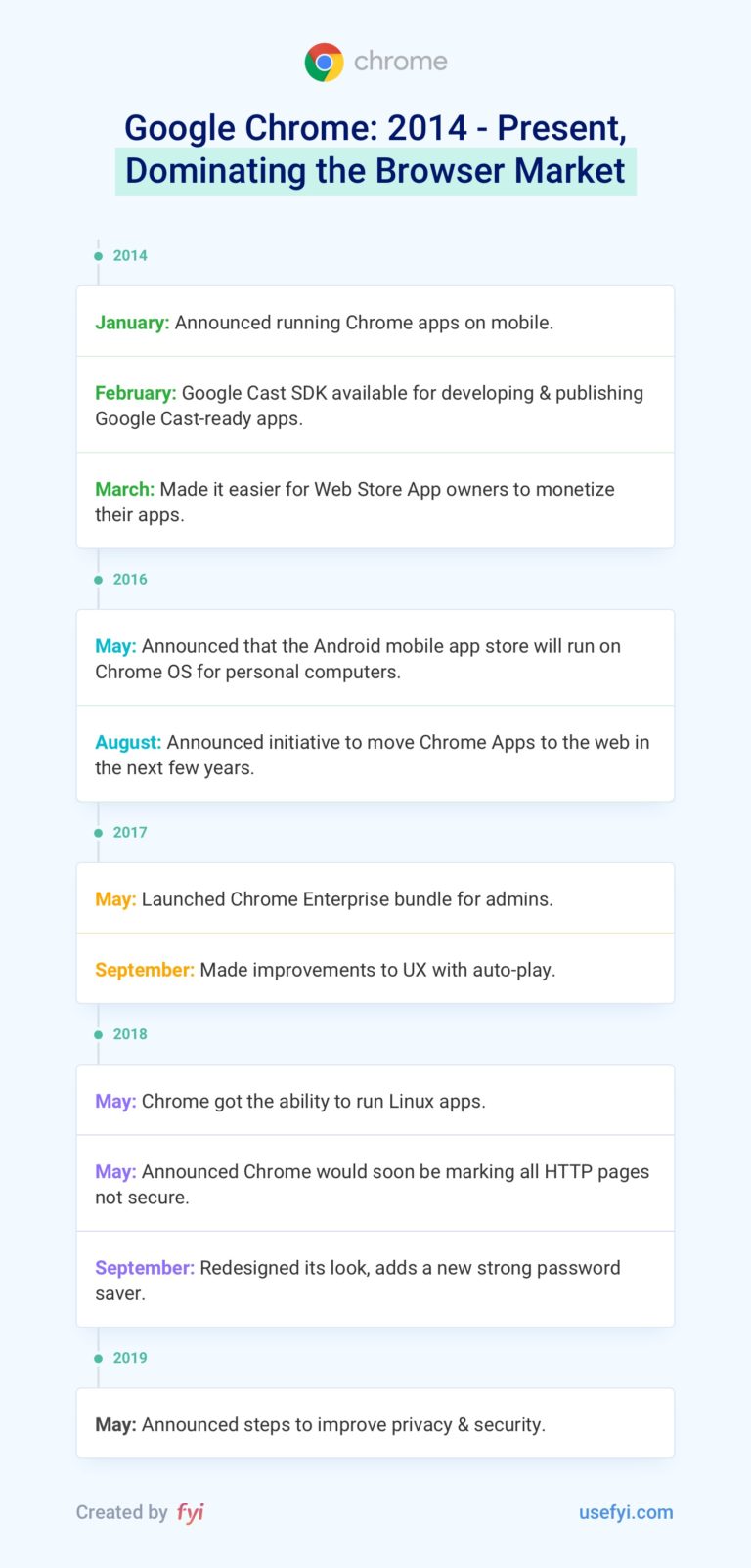
Google began 2014 in a confident position among browsers. Chrome occupied about 40% of the browser market, with a total growth of 155% over five years. Over 310 million people have used Chrome as their primary browser. Over the next few years, Google will actively use its position to seize Microsoft's continued market share, expanding Chrome’s presence around the world and creating new tools to cater to the changing lifestyle of people on the Internet.
The first significant step in 2014 was the launch of Chrome mobile apps in January. This was not the biggest event, but it was nice to see Chrome apps on mobile devices instead of being limited to just the desktop. Google used Chrome as a foothold for access to users who live on the Internet. Initially, this meant going side by side with PC users. Google wanted to penetrate almost all aspects of the online life of its users, and Chrome would be their vector.
Consistent with the spirit of Chromium projects, Chrome apps for mobile were created using Apache Cordova, an open source mobile app development environment for creating custom mobile apps using only HTML, CSS and JavaScript.
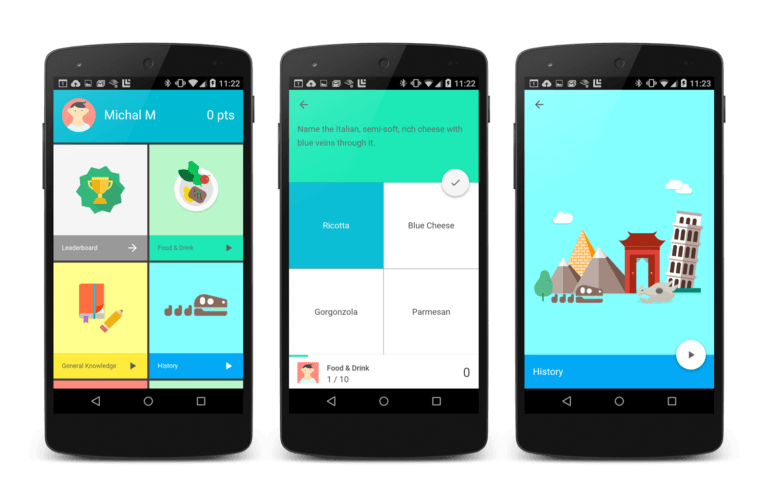
In March 2014, quite serious changes were made to how third-party developers could monetize their products. Prior to the upgrade, profit was only possible for extensions. Four methods were available: free trial, one-time upfront payments, subscriptions, and in-app payments. Now, application developers and those could take advantage of all these flexible monetization options.
What is noteworthy in this innovation is that extension developers got the best deal; many of the monetization options were not suitable for topics, and up-front payments and subscriptions could already be implemented in applications. Only the extensions were available all four monetization options as part of the update. At that time, it did not cause much excitement, but it was further evidence that Google clearly saw further steps to develop the ecosystem that was built on Chrome.
While Microsoft, Mozilla and Apple worked to make their own browsers more attractive, Google continued to gain new horizons. Speaking at the annual Google I / O conference in May 2015, then-product vice president Sundar Pichai confirmed that Google Chrome has crossed the line of 1 billion users worldwide.
Between 2014 and 2016, Chrome did not shine with vivid events, but this can not be said about other areas. In particular, 2015 has become a significant year for Chrome extensions. Their development was no longer considered as something frivolous, and turned into large projects with big money. , Dropbox Microsoft, Chrome, . Chrome , Cirrus Insight , Tout ( Marketo ) Yesware . , Chrome .
" , , . , , , - . , , ". — , TechCrunch
2015 . Microsoft 2015 , Edge, IE "Spartacus", . , Microsoft , Edge Windows 10, IE 12 2016 , , , Microsoft. Mozilla , API , WebExtensions , .
Chrome . Google " " . Chrome , "inline" -, Chrome Web Store 2011 . , Google. , , .
Google Android Chrome OS . 2016 , Google , Google Play Store Android Chrome OS, , . Android Chrome OS , Google Play Store, Chromebook, , Skype Microsoft.
Google , Chrome, Chrome OS, -.
" Chrome, , Chrome. Chrome: -. 1% Windows, Mac Linux , - -. - Chrome Windows, Mac Linux". — - , - Google
, Google 180 , ― Chrome , Chrome .
Google , - Google . , ? , , ?

Google Chrome . 2017 Google Chrome 55% . , Chrome , .
2017 Google Chrome Enterprise Bundle. Google Microsoft, Enterprise Bundle , Google - .

Chrome, . Chrome Legacy Browser Support, , . Google , , Chrome, "", - . Chrome Citrix XenApp Windows Server, . Chrome Enterprise Bundle , Google Microsoft .
Chrome 2017 , Google , , . , , , Google " " , UX Chrome . - -. , , - .
Chrome . Chrome 2018 , Google , Chrome Linux.
. , Linux . Google Linux — , . Chrome , Google . , Google , - 2008 , Google Linux Chrome , Chrome. , Google Android Studio Chrome OS , .
" Linux, , . , Google Chrome OS, , Chromebook , , ", — , The Verge
2018 Google , , HTTPS, " ". , Google . , , HTTPS , Chrome. , Chrome 70 2018 .
2018 10 Chrome. 2 Chrome, Chrome 62% . Chrome . , Chrome , Google .
Chrome , - -. , - , IE , Chrome. , . - Chrome Chrome . , Chrome, , Firefox, Opera .
Google -.
"Google , , , -. , Chrome , . , Google Chromium, ", — , Bloomberg.
, Google , . , Mozilla Brave Software, , "Chrome ". , Google ― Brave , , Chromium. , Vivaldi, , Google.
Google ― Gmail , , 2018 .
, Gmail Chrome, . , Gmail Chrome. . . 2018 , , — .

, Chrome, Google. Chrome Firefox. , Google , , . , 2018 .
Chrome Gmail , , Google , Google.
, , , Twitter, Google.
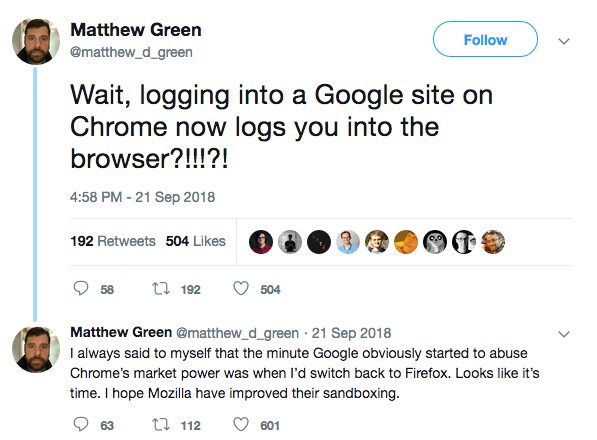
As expected, Green did not accept this view.
Google said that "consistency of identifiers between browser and cookie" will make it easier for users to move files and data between Google services. In this respect, Google was right - it was more convenient for some users. In addition, it was much easier for Google to identify user browsing habits, search history, and email, providing a much more complete picture of user behavior that could then be sold to advertisers. Google later rolled back and introduced a control that allowed users to more easily control automatic sign-in to Chrome.
“Even if the data doesn’t arrive [on Google’s servers], it’s still a huge change. It was their own rules that they created, and they violated them without telling anyone, and only updated their privacy policy after people came terrified. " - Matthew Green , Associate Professor, Johns Hopkins University
By May 2019, Chrome occupied almost 70% of the browser market share. Despite the fact that Firefox received its share of attention after various scandals related to Google privacy, other browsers were much less fortunate.
Work on Edge almost completely stopped - despite Microsoft's remarkable efforts to improve the browser. Probably, the significant increase in Edge's popularity can be explained by parasitism on Windows 10 . Between 2016 and 2019, Microsoft made dozens of improvements to Edge, making it faster, extensible, and stable, but there was still little reason to use Edge instead of Firefox or Chrome. Everything Edge could do, Chrome could do better.
That is why Microsoft's decision to switch Edge to the Chromium Engine in December 2018 was overwhelming.
Edge had many inherited problems that were difficult to overcome. Edge relied on a completely different rendering engine than Chrome and Opera, and this caused significant compatibility issues when displaying certain sites and pages. Edge also relied heavily on the Windows Universal Platform API (UWP), which further isolated Edge from the wider browser community.
After the initial shock subsided, many advocacy groups and online organizations supported Microsoft, especially in the Chromium developer community. But not everyone shared the enthusiasm for Microsoft's decision to switch Edge to Chromium. In particular, Mozilla was skeptical of this step, saying that it gave Google even more opportunities to develop future Internet technologies.
“From a business point of view, Microsoft’s solution may make sense. Google is so close to controlling the infrastructure of our online lives almost completely, so continuing to fight this could be unprofitable. The interests of Microsoft shareholders may well be ensured by giving up freedom and choice, that the internet once offered us. " - Mozilla
In just ten years, Chrome independently came up with what browsers can be, and has become the most popular of them. In addition to creating several new revenue streams for Google, Chrome has also helped expand its reach and reach a new audience with its products - and advertising.
However, despite its popularity, Google has been heavily criticized for Chrome’s privacy and security features. Chrome’s dominance is guaranteed so far, but from Microsoft’s example, we can conclude that things can change very quickly if Google can’t properly use its chances.
Where will Google Chrome go?
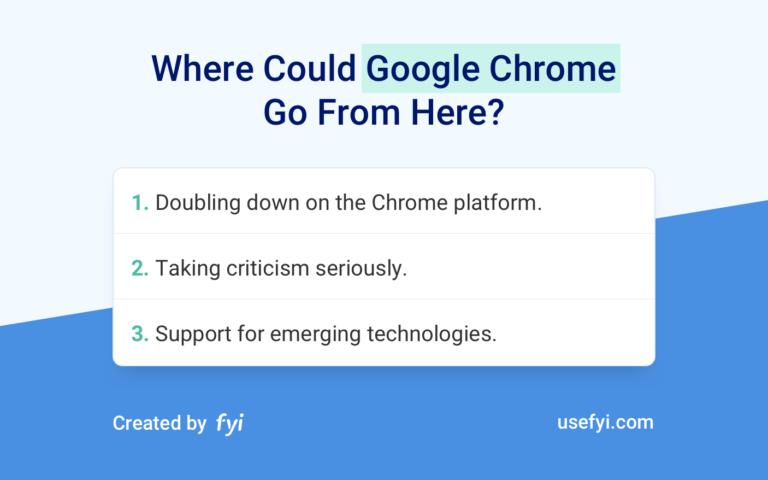
Take a dominant position in the browser market in just ten years, what will happen next?
- Focus on the Chrome platform. From the very beginning, Google introduced Chrome as a platform. As they strive to maintain control of the browser market, it is likely that the company will double bets on Chrome as a platform. This may include specialized tools, such as additional extensions specifically designed for mobile devices, and additional features for using the cloud in Chrome OS.
- A healthy response to criticism. For the most part, Google has done a lot to promote new Internet technologies and improve the network. However, it also sparked waves of criticism by making some dubious decisions, especially regarding user privacy. Google has always used Chrome to serve its users well, we hope that in the future, Google will begin to meaningfully solve more serious problems.
- Support for new technologies. If Google continues to work on the Chrome platform, it will inevitably introduce support for technologies such as Augmented Reality (AR) and Virtual Reality (VR) on the Chrome platform. Support for AR and VR represents an incredible opportunity for Google to take technology leadership again and an amazing opportunity for extra revenue.
What can you learn from Chrome?
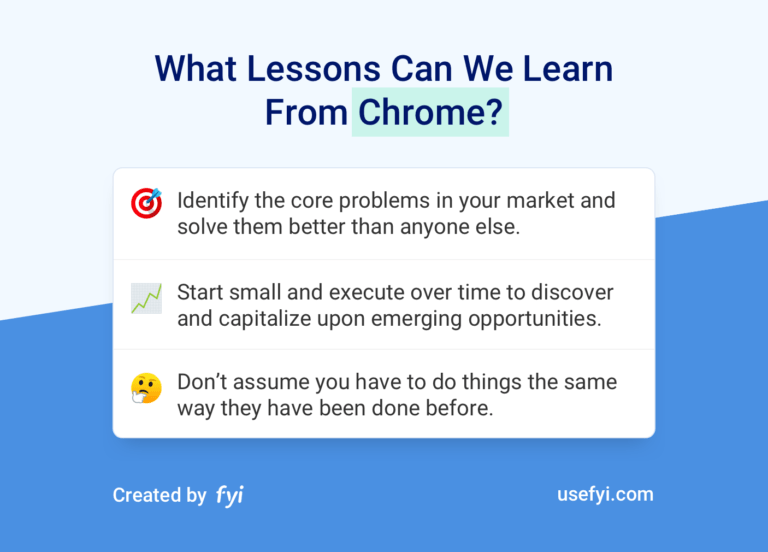
Few companies can compete in resources, reach or influence with Google. However, defeating a player like Microsoft on their own field in just ten years is no easy task, even for Google. What can we learn from the rapid rise of Chrome?
1. Identify the main problems in the market and solve them better than anyone else. Google’s early approach to Chrome development shows a deep understanding of the challenges, both technical and others, that the Internet industry faced around 2008. Google acknowledged that developers were a key growth vector for its new browser, and developed Chrome to meet the needs of both developers and users.
Look at your product and its place in your market:
- What are the biggest challenges facing your industry? Does your product solve these problems for other companies, consumers, or both?
- If you could change anything in your industry, from the limitations of existing technologies to how users perceive products in your vertical, what would it be? How can your products solve the most pressing problems of your market and improve what you have changed?
- To be honest, is anyone else in your space innovating like you? What could you do over the next six months to narrow the gap between your product and competitors?
2. Start small and change over time to discover new opportunities and take advantage of them. Google could create a better browser, improve it a bit and leave it as it is, but instead they created a better browser, which turned into a product and captured 70% of the market share, becoming a platform with a thriving ecosystem.
Consider a scenario for developing your product for the next year or so:
- How many options do you have to maneuver and take advantage of emerging opportunities? Does your script allow some deviation, or are you firmly committed to a certain path?
- How to achieve the opportunity to create additional product value for your users and new sources of income?
- What's on your list of "space" ideas? How can these ideas be explored without negatively impacting your current growth?
3. Do not think that you should do the same as before. The best products give people exactly what they expect from competing products, only in a much better way. For example, Google could have avoided anything remotely resembling a browser toolbar. Instead, Google developed Chrome Extensions and has since refined and refined them to completely circumvent issues with toolbars.
Find the most important issues you need to solve in your market and then innovate:
- What are the biggest problems people have with existing products on the market?
- What will your product do differently? Why will your product succeed where others have failed?
- Looking at your product, in what areas is it inferior to competitors? In other words, what are the weaknesses of your product and how can another company solve your customers' problems better than you?
Through the lines
In addition to creating a better web browser, Google was able to almost single-handedly change our interaction with the Web. Even users who prefer competitors have benefited from Google’s view of the browser as a platform, as other browsers have adopted the standards introduced by Chrome.
However, despite Chrome’s strengths as a browser and software product, Google made some costly mistakes, especially in collecting and using personal data. In the coming years, Google will have even more opportunities to shape the future of the Internet and the only real question is how responsibly will they do it?
All Articles